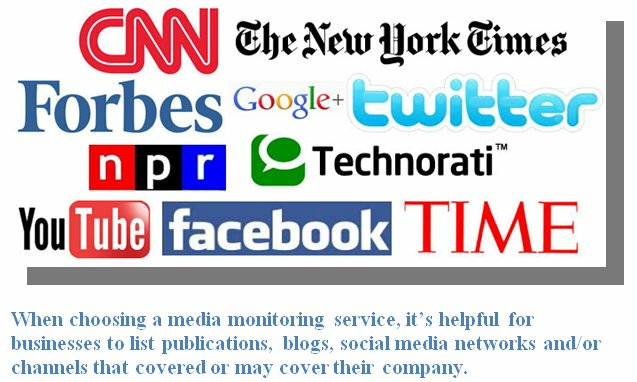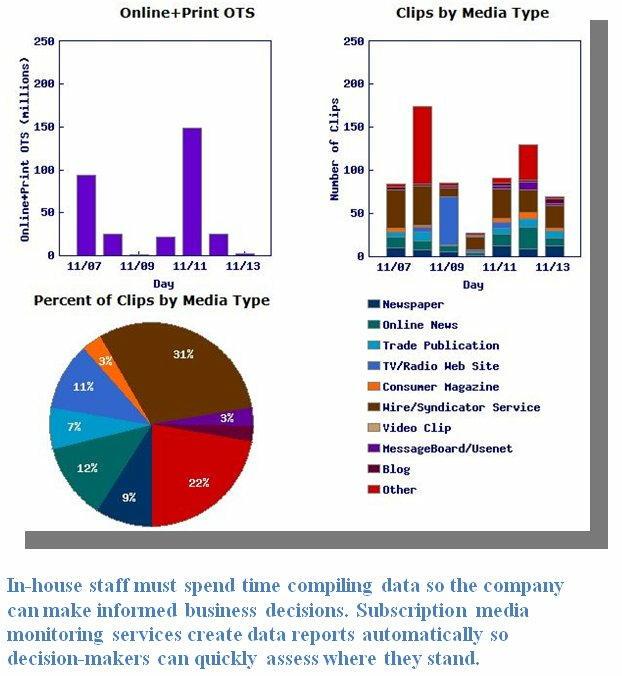Part 1: Free vs. Paid Tools: Which Should Your Business Use?
By William J. Comcowich, Founder, President & CEO, CyberAlert Inc.
Image of Media Monitoring Strategies for Small and Mid Sized Businesses Media monitoring services that offer in-depth analysis and shiny features are mostly geared toward big consumer brands and B2B companies with substantial PR and marketing budgets.
Small and mid-sized businesses don’t have a big budget to afford those tools, and frankly, don’t need many of the glitzy features that some media
monitoring services push on them. Many media monitoring tools and services are locked into a feature war, which distracts businesses from what’s really important: actionable results that inform business decisions.
Both free online tools and subscription services can deliver these actionable results. However, the choice depends on a business’s goals and market footprint.
Some small businesses can get by with free tools. But larger “small businesses” — including small and local B2B companies — have needs and a larger market presence that warrants a subscription media monitoring service.
Brands can decide whether a free or paid solution is right for their company by assessing the goals and scope of their media monitoring strategy.
When to Use Free Tools
The landscape for media monitoring has changed in just two years. Years ago, most all small and mid-sized businesses (SMBs) could get by without any form of media monitoring.
Image of Media Monitoring Strategies for Small and Mid Sized Businesses With the emergence of social media, most businesses — even small, local businesses like restaurants and car dealerships — must mine blogs, review sites and customer conversations to see what their customers say about them. A bad review can reach many eyes in a matter of hours and damage a business’s reputation. An unhappy customer can rapidly spread his/her discontent about a product or bad customer service through the social media world. If a business doesn’t monitor social media, it misses out on valuable market information, potential opportunities for growth and correcting misleading or negative conversations being spread.
SMBs with a very local market footprint and short-term goals may get by with free media monitoring tools like Google Alerts, SocialMention and Hootsuite. Free tools lack an integrated media monitoring solution, but many of these businesses, which include local B2C companies and retail stores, have very little news to monitor. If they’re featured in a local paper, they usually know about the placement beforehand.
Yet another type of “smaller business” exists that benefit from a subscription media monitoring service: small or mid-sized businesses that have regional or national market footprints and promote their business through a more dispersed market, thus needing the online news and social media monitoring integration benefits a subscription service offers.
It’s important to distinguish between the two, as assessing the footprint of your business will determine whether free tools make the cut for your media monitoring needs. How can businesses determine whether they fit into the “free tools” category?
Businesses should consider their market and media footprint to determine its coverage needs. Will free tools cover every publication, social media network and channel that talk about your brand?
Additional questions to ask about coverage:
*What media publications publish/broadcast your business?
*How many news and social media mentions does your brand receive in a day?
*Where is your business active online and in social media?
*Where is your audience active online and in social media?
*What keywords (and how many) should your business monitor?
*How much time will it take your designated employees to gather results from all these channels? Can your employees analyze these results and transform them into actionable data?
*How many staff members need access to media monitoring results?
*Do you plan to use media monitoring results for customer service?
cover, your business. A list helps businesses determine the types of media they should monitor — whether it’s online news, print news, social media, or a service that integrates all three — and if a paid service is needed to do so. Some organizations must monitor industry trade journals and niche publications. When that’s the case, they should look for a media monitoring service that’s flexible enough to add publications to their media list.
Workflow can also be important for companies monitoring news and social media, especially if they use social media for customer service. No business wants to end up responding to a customer twice with two different answers. Free tools rarely offer multiple-user access so staff can easily share data among themselves.
Comparing the “Costs” of Free Tools
Once a business has established its goals and media footprint, it can determine its media monitoring budget. This means weighing the cost of free tools (yes, free comes at a cost) against that of a subscription media monitoring service.
The advantages of free tools are quite obvious: they’re free, quickly accessible and offer a general overview of results.
But free tools have their shortcomings: they provide a limited scope and only a partial view of what customers and the media say about your business.
As free tools are do-it-yourself, they require businesses to designate one or multiple employees to collect results and analyze data.
Image of Media Monitoring Strategies for Small and Mid Sized Businesses Each free tool offers a “niche” monitoring service: Google Alerts monitors only
Online news; Hootsuite tracks only social media conversations; and Klout interprets social media influence. For reasonably comprehensive media coverage, it is necessary to use at least 8 to 12 separate free tools — a time-consuming daily process. Using free tools, then, makes economic sense for companies that employ volunteers or unpaid interns to perform media monitoring and measurement functions.
With all the back-and-forth switching between platforms to find relevant data and aggregate it into a single report, businesses may spend more time and money employing in-house staff to monitor than they would hiring a subscription media monitoring supplier.
Depending on a business’s volume of mentions, it can take over an hour — and sometimes several hours — each day for in-house staff using free media monitoring tools to:
*Search social media sites to find company, product and competitor mentions;
*Store media clips in an easily searchable format for future reference;
*Aggregate media mentions into a single file for analysis and share with employees, partners and clients;
*Convert the information into measurable data;
*Measure the data to determine the clips’ prominence, reach, sentiment and other factors.
Do-it-yourself monitoring is not as reliable as a subscription media monitoring supplier. If your business has a busy day, will your designated employee(s) still be able to spend as much time assessing media monitoring results? A major benefit of a subscription service is that it guarantees all your clips will be monitored, measured and delivered to your business on a daily or real-time basis.
These same rules apply to PR agencies that service SMBs. Not only is it virtually impossible for a small PR team to do the media monitoring work for multiple businesses — it’s also unrealistic to expect the results and data to be reliable. PR agencies should instead employ a media monitoring service that enables them to subscribe to multiple clients. CyberAlert’s Partner Program, for instance, delivers media monitoring services to agencies so they can resell the service to their clients under their own logo and price terms.
It’s best for PR agencies and SMBs to explore their options through the media monitoring free trials that services offer to determine which publications, channels and metrics are important to their business. During this experiment, you can also determine just how much time and resources you invest in your current media monitoring plan, and decide on reasonable budget expenditures per month or annually.
The bottom line: Free monitoring tools rarely provide the media coverage sought by most organizations with a larger market footprint, and require substantial staff time to conduct daily media searches and aggregate the data. The outcome: low-quality results and high staff costs.
Just because your company falls under the “small business” category, doesn’t mean it should use free tools. A business’s media monitoring budget depends on its footprint and goals. For small and mid-sized businesses that have a regional or national footprint and long-term goals, outsourcing media monitoring to a subscription service delivers the best deal: better coverage and smaller time investment.
About the Author: William Comcowich is founder, president and CEO of CyberAlert Inc., a worldwide media monitoring service for online news, broadcast news and social media. With over 40 years of communications experience in public relations, marketing and production of multimedia programs for major corporations, Mr. Comcowich edits the CyberAlert Blog and Media Monitoring News, a weekly newsletter on public relations, marketing and social media.







